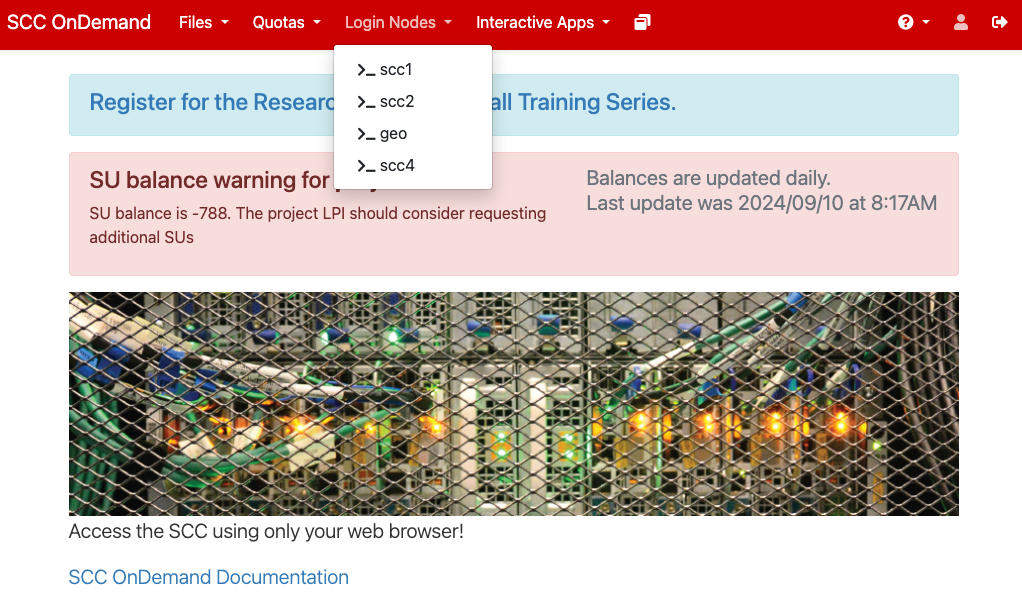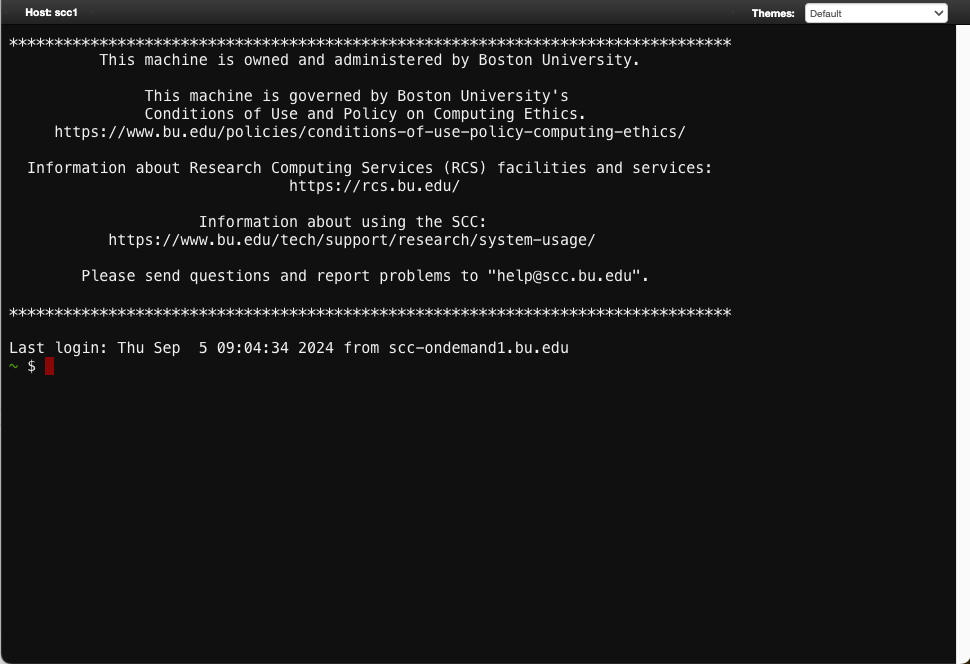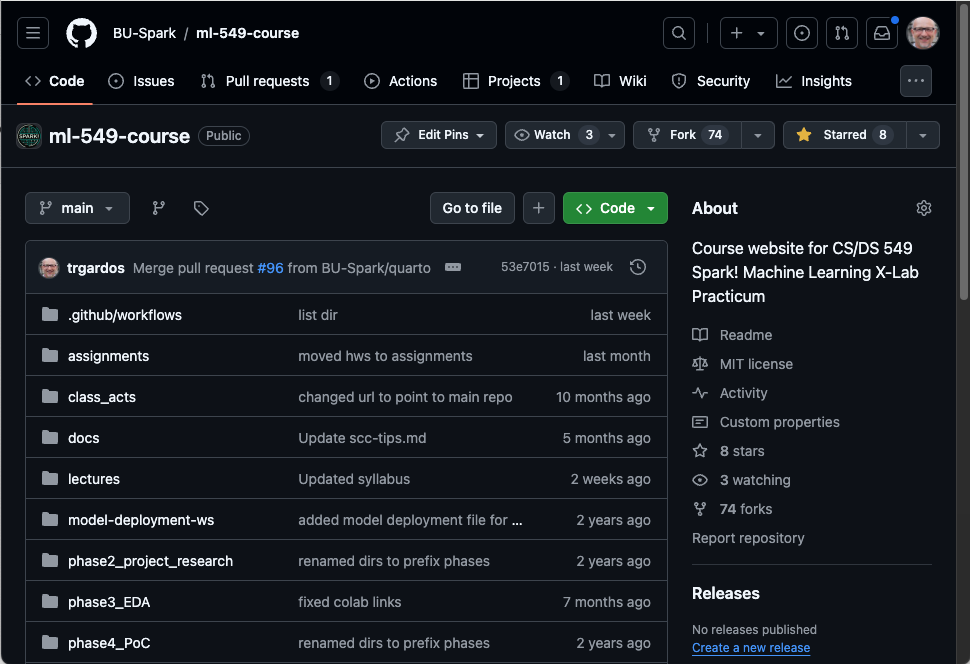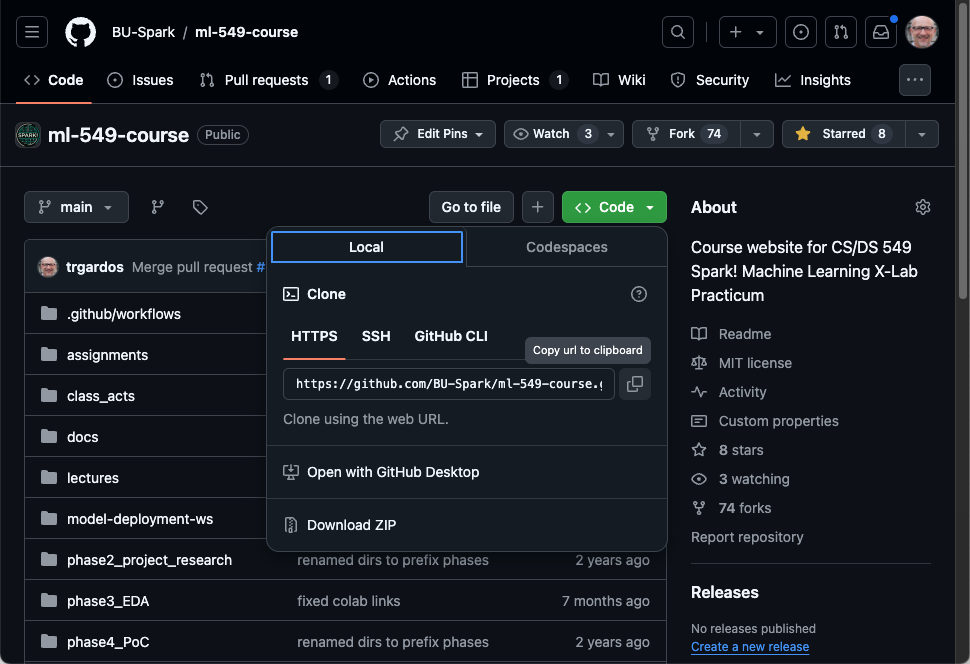Shared Computing Cluster
Intro to SCC

BU’s Shared Computing Cluster (SCC) is heterogeneeous Linux cluster composed of both Shared and Buy-in nodes.
Currently:
- Over 12,000 shared CPU cores
- Over 16,000 Buy-in CPU cores
- Over 400 GPUs
- 14 Petabytes of storage
CDS has buy-in nodes also.
SCC

The easiest way to get to a terminal session on the Shared Computing Cluster (SCC) is to navigate to SCC On Demand.
The nodes you see on the list are the login nodes.
- You are restricted from running computation workloads on the login nodes.
- Use them for simple file access and to submit jobs to the queue system.
- Heavy computation processes will be killed after a few (15?) minutes.
- Heavy computation processes should be run on the compute nodes via the queueing system or from interactive sessions.
SSH Connection to SCC Login Nodes
You can also ssh to the login nodes:
<username>@scc1.bu.eduor<username>@scc2.bu.eduor<username>@scc3.bu.edu
The first time you ssh, you might get the message a like this with scc1:
The authenticity of host 'scc2.bu.edu (192.12.187.131)' can't be established.
ED25519 key fingerprint is SHA256:OmvL4FQ48QTpcXDpYE63rse1tM6pfKfSUgaVW1+mlIw.
This key is not known by any other names.
Are you sure you want to continue connecting (yes/no/[fingerprint])? Just type yes and hit return.
Connect to Login Node

Let’s connec to a login node.,
You’ll start in your home directory.
$ pwd
/usr2/faculty/tgardosYou can show the processes you’re running with ps.
$ ps
PID TTY TIME CMD
3507536 pts/328 00:00:00 bash
3518333 pts/328 00:00:00 psWhich says you are running the bash shell and also the ps command.
Updating your prompt
As we showed before, you can update your prompt to show the current working directory and the current git branch (if you’re in a git repository).
Add the following lines to the end of your .bashrc file:
parse_git_branch() {
git branch 2> /dev/null | sed -e '/^[^*]/d' -e 's/* \(.*\)/(\1)/'
}
export PS1="\[\e[32m\]\w \[\e[91m\]\$(parse_git_branch)\[\e[00m\]$ "Then either exit and restart your terminal or just run source ~/.bashrc this time.
SCC Group Membership
We’re in a shared computing environment, so we have to be careful about group membership and file permissions.
You’ll be a member of a group for every project or class you’re in on SCC.
To see what groups you’re in, you can use the groups command:
~ $ groups
sparkgrp ds549 ds549-ta ds598 ds598ta herbdl ai-tutor spareitThe above are all the groups I’m in.
But you have to be pay attention to what your current default group is.
You can see what your default group is with the id command:
~ $ id
uid=426625(tgardos) gid=363482(sparkgrp) groups=363482(sparkgrp),430422(ds549),430527(ds549-ta),450171(ds598),450177(ds598ta),450334(herbdl),450346(ai-tutor),450373(spareit)This shows my user ID (uid) and my default group ID (gid) which is currently sparkgrp.
Most of you will likely be in the ds549 group. When you get assigned projects, you will also be added to the sparkgrp group.
If you just want to just see your default group, you can use the command:
~ $ id -ng
sparkgrpWhy does default group matter?
Remember back in 01_command_shells.qmd we talked about file permissions?
To recap, with the ls -l command I showed you:
$ ls -al
total 2
drwxr-sr-x 3 tgardos ds549 4096 Sep 6 2023 .
drwxr-s--- 9 root ds549 4096 Jan 26 2023 ..
drwxr-sr-x 9 tgardos ds549 4096 Apr 9 12:35 tgardosThe file permissions are a string of 10 characters. The first character is the file type. The next 9 characters are the file permissions in triplets corresponding to the user, group, and other permissions.
In each triplet, the first character is the read permission, the second character is the write permission, and the third character is the execute permission. If there is - in the triplet, it means the permission is not granted.
If there is a @ at the end of the line, it means the file has extended attributes.
group permissions
file type | extended attributes
| --- |
drwxr-xr-x@
--- ---
| |
| other/world permissions
user permissionsWhen you are collaborating with others:
- You have to make sure you give
r/wpermissions to the group. - You have to make sure the file or directory is owned by the right group
To change my group to ds549, I can use the newgrp command:
$ newgrp ds549
$ id -ng
ds549To Change File or Directory Permissions
From my home directory, I’ll create a directory and change into it:
~ $ mkdir tempdir
~ $ cd tempdir
~/tempdir $ ls -al
total 1
drwxr-xr-x 2 tgardos sparkgrp 4096 Sep 10 13:03 .
drwx------ 40 tgardos sparkgrp 4096 Sep 10 13:03 ..I’ll create a file and check ownership and permissions:
~/tempdir $ touch file1.txt
~/tempdir $ ls -l
total 0
-rw-r--r-- 1 tgardos sparkgrp 0 Sep 10 13:03 file1.txtSee that it created a file with my default group sparkgrp.
~/tempdir $ id -ng
sparkgrpNow, I’ll change the group permissions of the file:
~/tempdir $ chmod g+w file1.txt
~/tempdir $ ls -l
total 0
-rw-rw-r-- 1 tgardos sparkgrp 0 Sep 10 13:03 file1.txtLet’s change my default group to ds549:
~/tempdir $ newgrp ds549
~/tempdir $ id -ng
ds549Now let’s create another file and check ownership and permissions:
~/tempdir $ touch file2.txt
~/tempdir $ ls -l
total 0
-rw-rw-r-- 1 tgardos sparkgrp 0 Sep 10 13:03 file1.txt
-rw-r--r-- 1 tgardos ds549 0 Sep 10 13:07 file2.txtSee that I have files from both groups. People in sparkgrp can read and write to file1.txt and people in ds549 can read from file2.txt.
SCC Projects
You won’t want to do much work in your home directory.
For starters you have limited storage quota.
$ quota -s
Home Directory Usage and Quota:
Name GB quota limit in_doubt grace | files quota limit in_doubt grace
tgardos 7.64500 10.0 11.0 0.0 none | 86,169 200,000 200,000 19 noneCheck my current default group:
$ id -ng
sparkgrpYou should each be in the ds549 project.
~ $ cd /projectnb/ds549
/projectnb/ds549 $ ls
admin archive datasets materials projects README.md students workspacesYou each have a dedicated working directory in students.
/projectnb/ds549 $ cd students
/projectnb/ds549/students $ ls
abhaya13 anandro chimmay fahuddin hengc jmstein markmaci mounika5 shivenrk songfan xudd
ac25 ayush25 daf gluzmans jianying manavk marychoe mvoong smallk thannah yuanlj
alokma bmv2021 enricoll grbxni jinanshi marekp mchg njquisel solheim wycheng ywnlYou will each be added to the sparkgrp group as well.
Super important point. You each should be working on your own copy of the project repo in your own working directory. Use GitHub for asynchronous collaboration.
SCC GitHub Exercise

Let’s do a quick exercise to get you comfortable with using GitHub from SCC.
Navigate to https://github.com/bu-spark/ml-549-course.
Fork the repo to your GitHub account.

Navigate to /projectnb/ds549/students/<your-username>.
Clone the repo to your working directory.
$ git clone https://github.com/BU-Spark/ml-549-course.git
$ cd ml-549-course
$ git remote -vNow let’s create a new branch and make some changes.
$ git checkout -b my-new-branchIf you updated your .bashrc you should see your branch in the prompt.
$ touch my-new-file.txt
$ git add my-new-file.txt
$ git commit -m "Add my new file"
$ git push origin my-new-branchNow if you wanted, you can create a pull request from your branch in your forked repo back to the main repo.
Future SCC Topics
- Managing python environments on SCC
- SCC batch compute jobs
- Listing CDS queues and resources
- understanding the queueing system
- submitting jobs
- monitoring jobs
- debugging jobs
- SCC interactive sessions
You can see some of this info on my SCC Tips